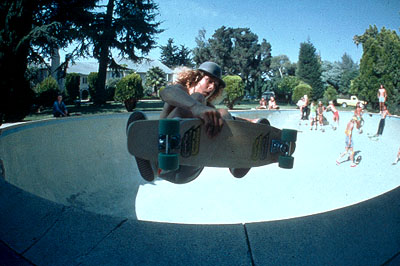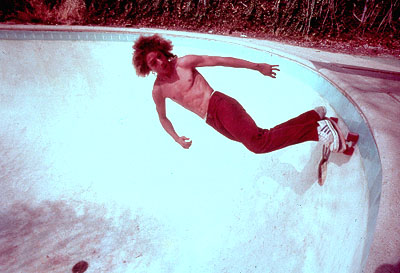

There are two broad categories of documentaries. One is a non-biased approach that seeks to present a story from all sides. The second tells a story primarily from one point of view. Dogtown and Z-Boys, surprise winner of Director's and Audience Award for documentaries at the 2001 Sundance Film Festival falls squarely into the latter category. However, this is not necessarily a bad thing. Dogtown details the birth of modern skateboarding from its humble roots in Dogtown, Southern California (aka Venice Beach). Its love and enthusiasm for the sport is so infectious that the audience cannot get but get caught up in the rush of these young boys who some consider the forefathers of extreme sports. It helps that some of the people in the film are also the people behind the camera, which also explains the almost religious adulation heaped upon its subjects. It's all one big pat on the back, but a fun one at that.
Before its modern incarnation, skateboarders primarily stood upright and performed a variety of tricks that look retarded in comparison to what people do today. The Zephyr team was a group of young skaters who got their start surfing. They emulated surfing tricks on skateboards, riding low and weaving quickly. These kids have a roguish, anti-establishment sensibility that arose from their upbringing. They lived around Venice Beach, Ca, a run-down, fiercely territorial area. Their only solace was the Zephyr Surf Shop, owned by Jeff Ho, Skip Engblom, and Craig Stecyk. The kids hung out here, surfing in the mornings and skating in the afternoon when the waves became less amenable. The invention of polyurethane wheels for skateboards triggered a resurgence in the nearly forgotten sport, and a new renaissance for these kids. The areas around Venice were ideal for skating, with lots of concrete. A drought led to an abundance of dry swimming pools, which the skaters commandeered for their own purposes. They would drive through neighborhoods atop cars looking for houses with pools they could empty.
Dogtown and Z-Boys is relatively short, so there is not enough time to adequately get to know each of the skaters. All of them have colorful personalities, and speak with surprising grace (if not a little rough at times) about their childhood passion (some still skate today). There is a lot of actual footage of the Zephyr team in their prime, transferred from 8mm to the big screen. The stunts look just as spectacular as they did nearly two decades ago. Stacey Peralta directed and co-wrote the documentary with Stecyk, who was primarily responsible for catapulting the Zephyr team and their unique style to fame through a series of articles in Skateboard Magazine. Sean Penn (I Am Sam, Before Night Falls) provides the narration, sometimes sounding like he's extremely bored. The documentary naturally segues into the history of Venice, surfing, and the experiences of the Zephyr team after their vault into stardom, much of which encompasses lucrative licensing deals. Peralta does well by including this, since it shows what influenced them as well as what they were later able to influence.
By far the best (and most fun) part of this movie is tracking the progress of individual skaters. Peralta spends the most time on Jay Adams and Tony Alva. Adams was the youngest, and by consensus, the most talented Z-boy. His peers though him insane for some of the improvisations he did on the board, yet still managed to make it look cool. Alva was the one with the most grace. He was also the one who was first to go up over the side of a pool and back down. All of them together are a volatile mix that soon explodes, and everybody goes their separate ways. Still, they reminisce fondly on their bygone days. Engblom, and Z-Boys Wentlze Ruml and Bob Biniak provide most of the commentary, with Peralta himself stepping in probably to provide better transitions. It would be nice to see some other viewpoints, but in the end, the bravado and braggadocio of the Z-boys wins out.